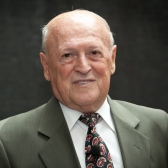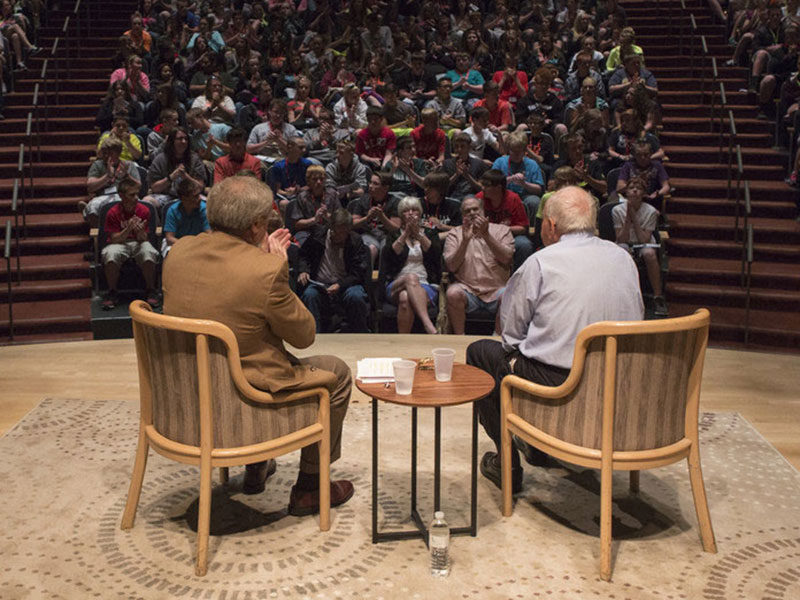June 30, 2009
Isak Danon discusses the attack on the synagogue in his hometown of Split, Yugoslavia, in the summer of 1942. Germany had invaded Yugoslavia in April 1941, and shortly after Split was occupied by the Italians, allied to Nazi Germany.
LISTEN
Esta página también está disponible en español.
TRANSCRIPT
ISAK DANON:
We saw a lot of prayer books half burned. I even choke up when I think about it. And we went to the synagogue they burned that too.
NARRATOR:
Over 60 years after the Holocaust, hatred, antisemitism, and genocide still threaten our world. The life stories of Holocaust survivors transcend the decades and remind us of the constant need to be vigilant citizens and to stop injustice, prejudice, and hatred wherever and whenever they occur.
This podcast series presents excerpts of interviews with Holocaust survivors from the United States Holocaust Memorial Museum’s public program First Person: Conversations with Holocaust Survivors. In today’s episode Isak Danon talks with host Bill Benson about the attack on the synagogue in his hometown of Split, Yugoslavia, in the summer of 1942. Germany invaded Yugoslavia in April of 1941, and shortly after Split was occupied by the Italians.
ISAK DANON:
So one day, my sister and I were going to the synagogue, Friday night. Our store was near the synagogue so we said, “Let’s go get our father and he’ll come with us to the synagogue.” Well we went there and there was a lady that kept him busy, you know, last minute shopper, and we were saying, “Come on Daddy, Let’s go. Let’s go.” He says, “Okay.” She says, “Just one more thing.” Anyway, she finally left, we were late, so we hurry up toward the synagogue and we had to cross the city square to get to the synagogue.
The city square is usually full with people and there is outdoor cafes and all that. Well this time everything was quiet except you saw people running, and these Fascist Blackshirts with the guns, with the rifles hitting people and knocking them down, kicking them. We were sort of scared and my father recognized some of these people. So he grabbed me and my sister, “Come on.” And we went around, we left there and went all around the city to get to our house. We didn’t know what was taking place, but my father sort of had a feeling. So we went to the house of a rabbi who lived near us and he told us that the services had started when these guys walked in, the Blackshirts, about 10, 12 of them.
BILL BENSON:
Right into the service?
ISAK DANON:
Into the service. They said, “Who is in charge here?” They talked to the rabbi and he says, “Yes, what can I do for you?” He says, “Okay, services are over. Get everybody out.” So he told them, “Okay these are Italian Fascists controlling everything.” So he told the people to leave.
Well as they were leaving there was like steps leading to the square and the Fascists made a gauntlet with their rifles and they kept hitting everybody as they were coming out.
BILL BENSON:
In the only way they could go to get downstairs?
ISAK DANON:
That’s the only way out. One thing to their credit, that’s what the rabbi said. There were two older people, two elderly gentlemen, and they would yell, “Let him go. Let him go.” Liberto means free, let him pass. They didn’t hit them. But everybody who was, you know, the rabbi had broken teeth and blood was coming out.
Anyway, and we were very scared, so next morning my sister, the one that came with me, and I went early in the morning we went downtown to see what had happened. We went to…first store that we came to was my uncle’s. He sold perfumes and cosmetics. The store, the window was shattered. Inside the store was just glass all over the place. There wasn’t a single bottle of perfume left. All the cases destroyed, everything.
Then we went on toward our store. There was a camera shop. Camera shops usually had a lot of cameras. You didn’t see any, just broken glass, cases. Then we went to our store and that was lucky for us, like I said my father had a very small store, we called it “hole in the wall.” It didn’t even have the windows to display the merchandise. It was just big, heavy, wooden doors. We saw signs of how somebody was hammering but they couldn’t break it. They just broke the signs on top, you know and all that.
So, on the city square there was a lot left over from the bonfire. We saw a lot of prayer books half burned. I even choke up when I think about it. And we went to the synagogue they burned that too. And from there on we didn’t have a synagogue. People who wanted to do the services they would come to our house so we can have a congregation there. Or some other people would have in their houses. That’s how the life continued.
NARRATOR:
You have been listening to First Person: Conversations with Holocaust Survivors, a podcast series of the United States Holocaust Memorial Museum. Every Wednesday at 1 p.m. from March through August, Holocaust survivors share their stories during First Person programs held at the Museum in Washington, DC. We would appreciate your feedback on this series. [Please take our First Person podcast survey (external link) and let us know what you think.]
[On] our website you can also learn more about the Museum’s survivors, listen to the complete recordings of their conversations, and listen to the Museum podcasts Voices on Antisemitism and Voices on Genocide Prevention.


